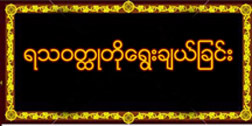Theravada Tradition: A Historical and Doctrinal Study
ME35 31-03-2011 (4:00 to 5:00)
(Class Notes Only)
-------------------
The Buddha's teaching is a "doctrine of analysis" (vibhajjavāda). His analysis examines the given world of sense experience, and in so doing sees that entities which appear solid and lasting break up into a series of shifting experiences. The word Vibhajjavāda may be parsed into vibhajja, loosely meaning "dividing", "analyzing" and vāda holding the semantic field: "doctrine", "teachings". The analysis of phenomena (dharmas) was the doctrinal emphasis and preoccupation of the Vibhajjavādins.1.Vibhajjavādi mandalam otāretvā,
2.Cattāro mahāpadesa olokentena (ekamsañyā karana,vibhajja karana,
patipucca karana and thapaniya karana),
3.Ᾱcariya anabbhā eikkhantena (Sri Lanka),
4.Dhammam dīpantena (clearing the Dharma),
5.Attham sangahan tena,
There are, Maṅgala Sutta is so very popular because of the wide range of its teaching within a few easily remembered verses. Which is characteristic of the ‘Dharma’ as a whole. The Maṅgala Sutta is text for the wholesome shaping of complex human civilization. In this work an attempt is made to offer some studies of this important discourse of the Buddha, for the material and spiritual well-being of individuals in a democratic society. The discourse provides lessons of direct practical application.
Once while the Blessed One was staying in the vicinity of Sāvatthī, in the Jetavana, in Anāthapiṇḍika’s monastery, a certain god, whose surpassing brilliance and beauty illumined the entire Jetavana, late one night came to the presence of the Blessed One; having come to him and offered profound salutations he stood on one side and spoke to him reverently the verse. Here, we want to explain some verse: they are-
“Asevanā ca bālānaṃ, paṇḍitānan ca sevanā, pūjā ca pūjanīyānaṃ,” With fools no company keeping, with the wise ever consorting, To the worthy homage paying. “Mātā-pitu upaṭṭhānaṃ, puttadārassa saṅgaho, anākulā ca kammantā,” Mother and father well supporting, children and wife duty cherishing, types of work un-conflicting. “ñātakānan ca saṅgaho,” Relatives and kin supporting. “Tapo ca brahmacariyan ca, ariyasaccāna dassanaṃ, nibbānasacchikiriyā ca, etam maṅgalam-uttamaṃ.” Self-restraint and holy life, All the Noble Truths inseeing, Realisation of Nibbāna: This, the Highest Blessing.
6. Tamevattam punarāvattetva, Opachip pariyayehi niddisau tena,
7. Vinayam anulomen tena,
8. Stuttam appatibahentena.
Buddhaghosa, the great fifth century commentator, casts light on this question in a playful linguistic analysis found early in the Paññabhūminiddesa of his Visuddhimagga. The Visuddhimagga is investigation, mindfulness, and wisdom. This further shows the supremacy of completing an analysis and attaining wisdom in the Buddha’s religion and a rejection of blind faith.
The Vibhajjavādins are not recorded uniformly by early Buddhist traditions as being a distinct sect. The Theravādin Kathāvatthu does not contain any reference to a Vibhajjavāda school, but the Sammatīyas and the Mahāsāṃghika do mention the Vibhajjavādins. According to the Sammatīya sect, the Vibhajjavādins developed from the Sarvāstivāda school. The Sarvāstivādin Abhidharma Mahāvibhāṣa Śāstra describes the Vibhajjavādins. The Theravādins of Sri Lanka may have been Sthavira-Vibhajjavādins.
The First Buddhist council was convened in the three months after the Buddha's Parinibbāna, which is 543–542 BC, according to Theravada tradition, sponsored by King Ajātasatthu outside the Sattaparnaguha in Rājagaha. Detailed accounts of the council can be found in the Khandhaka sections of the canonical Vinayas, under the leadership of Mahakassapa to call this meeting was his hearing a disparaging remark about the strict rule of life for monks.
The passing of the Buddha, Subhaddā spoke up to show happiness and relief that Buddha was gone. With the Elder Mahākassapa presiding, the five hundred Arahant monks met in council during the rainy season. This historic first council came to be known as the Pancasatika. It took the monks seven months to recite the whole of Vinaya and Dhamma. The Second Buddhist council took place approximately one hundred years after the Buddha's parinirvāṇa. It occurred in Vaiśālī, and was held over ten points which amounted to minor infringements of the Bukkhu and Bukkhuni Vinaya, such as handling money and eating after midday.
This Council made the unanimous decision not to relax any of the rules, and censured the behavior of the monks who were accused of violating the ten points. The first schism which divided the early Buddhist Sanghā into two primitive schools the Theravada school ‘11’and the Mahāsanghika school ‘7’. Some sub-divisions of Sthavira school which termed as the followers of Vibhajjavāda. Those not included in the Vibhajjavāda group were the Mahāsāṃghikas. Dipavamsa, Mahavamsa, Samantapasadika are from Southern Vibhajjavada lineage.
The Third Buddhist Council, was crowned in the two hundred and eighteenth year after the Buddha's death an event dated by modern scholars to 246 BC, under the leadership of Moggaliputta Tissa emphasized this analytical approach, in order to refute a number of heresies and ensure the Dhamma was kept pure, compiled a book during the council called the Kathavatthu.
This book is the fifth of the seven books of the Abhidhamma Pitaka. According to Sinhalese tradition, Buddhism under the name of Vibhajjavāda, was brought from India to Sri Lanka by Venerable Mahinda, who is believed to be the King Asoka, he changed, when he met the pious novice Nigrodha who preached him the Appamada-vagga. There-after he ceased supporting other religious groups and his interest in and devotion to the Dhamma deepened. His son Mahinda and his daughter Sanghamitta were ordained and admitted to the Sangha.
by Ashin Indaka (Kyone Pyaw)























0 comments:
Post a Comment